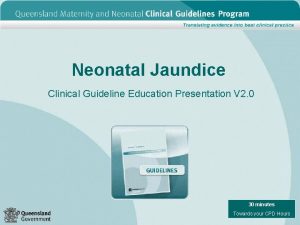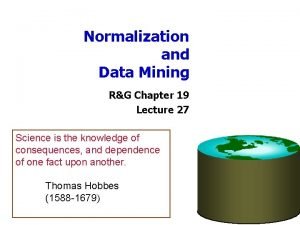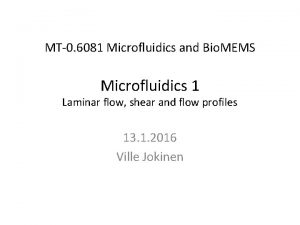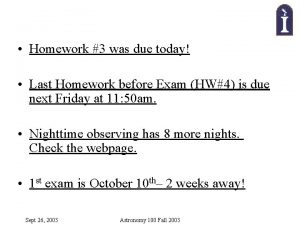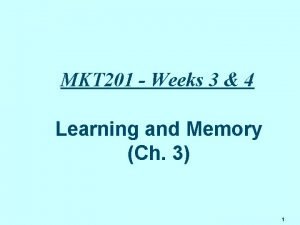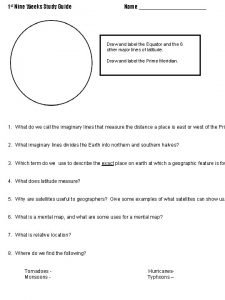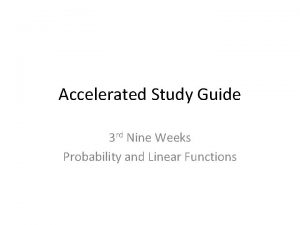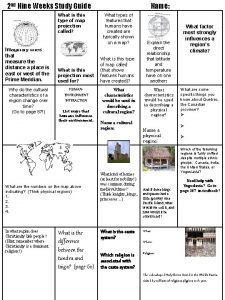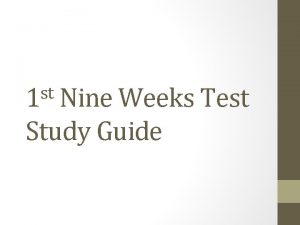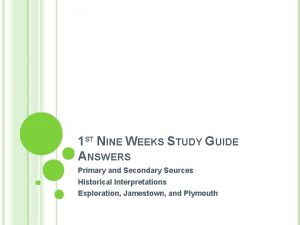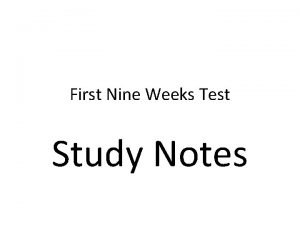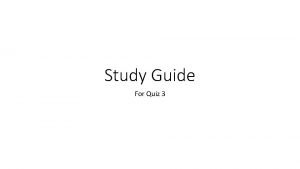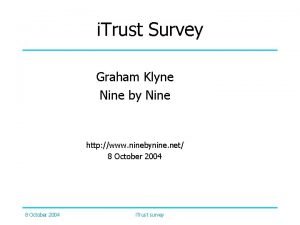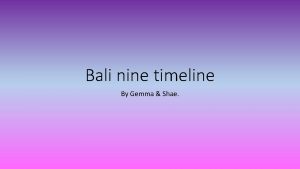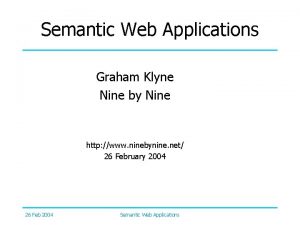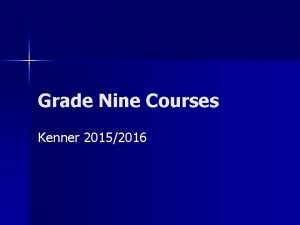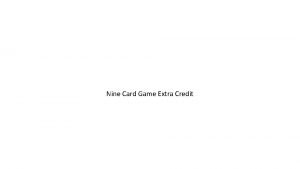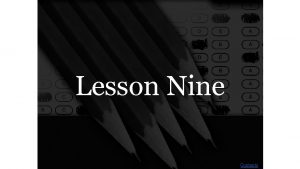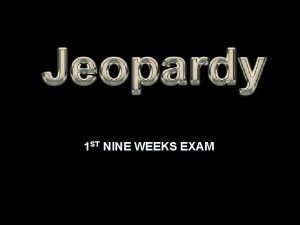rd 3 Nine Weeks Study Guide 2014 DATA


























- Slides: 26

rd 3 Nine Weeks Study Guide 2014

DATA SET : 21, 45, 65, 18, 44, 45, 44, 22, 63, 64, 37 Order the numbers from least to greatest: 18, 21, 22, 37, 44 , 45, 63, 64, 65 1. Mean = 42. 54 (Add all data values, then divide by how many you have) 2. Median = 44 (Locate the number in the middle, if there are two numbers in the middle, add them and divide by two. ) 3. Mode = 44, 45 (Find the number that occurs the most often) 4. Range 65 -18 = 47 (The difference of the largest and smallest numbers)

DATA SET : 21, 45, 65, 18, 44, 45, 44, 22, 63, 64, 37 Order the numbers from least to greatest: 18, 21, 22, 37, 44 , 45, 63, 64, 65 1 st: Locate the median. 2 nd: Find the median of the lower half. 3 rd: Find the median of the upper half. 4 th: Locate the smallest number. 5 th: Locate the largest number. • • • Min. 18 LQ – 22 Med. – 44 UQ – 63 Max - 65

Data Set: 7, 10, 12, 13, 13, 15, 16, 17, 18, 20, 21 6. Find the 5 number summary • Min. : 7 • LQ : 12. 5 (12 + 13 = 25; 25/2= 12. 5) • Med. : 14 (13 + 15 = 28; 28/2= 14) • UQ : 17. 5 (17 + 18 = 35; 35/2 = 17. 5) • Max : 21 • IQR : 5 (17. 5 – 12. 5 = 5)

7. Box and Whisker Min: 7 LQ: 12. 5 Med: 14 UQ: 17. 5 Max: 21 Lower 25% quartile is from 7 to 12. 5 Middle 50% is 12. 5 to 17. 5 Upper 75% is from 17. 5 to 21 8. Interquartile Range is the size of the box. 17. 5 – 12. 5 = 5

Box and Whisker 9. IQR – tells us how far the data is spread – how much it varies 10. Outlier – the number far away from the rest of the data (1. 5 half times the size of the box) 25% 50 % 25%

Central Tendency Which measure of center is the best to use? Mean Median Mode 11. Median and Mode – not affected by outliers 12. Mean – is affected by the outlier 13. If there is an outlier – use the median

Sampling 14. Random Sample – draw names out of a hat, pick every 5 th person etc. Convenience Sample – Everyone who comes to the game, the store, those at the online website 15. Biased sample – only surveying on Saturday, only using a certain age group, only those at practice

16. Mean Absolute Deviation • Aubrey’s Game Scores 487, 512, 587, 620 • Cullen’s Game Scores 450, 520, 554, 560, 618 • Mean = 551. 5 • Mean = 540. 4 Step 1: find the mean Step 2: subtract all data values from the mean. Step 3: find the mean of the differences from step 2. • 64. 5 + 39. 5 +35. 5+68. 5 (Divided by) 4 • MAD = 52 Step 1: find the mean Step 2: subtract all data values from the mean. Step 3: find the mean of the differences from step 2. • 90. 4+20. 4+13. 6+19. 6+ 77. 6/ 5 = 44. 32 • MAD = 44. 32 • Cullen has a lower MAD, so more consistent. Meaning the data is less spread out.

17. Find x 1. Determine the relationship of the given angles. They are alternate interior angles. 2. Use the relationship to write an equation. Alternate interior angles are congruent, so 2 x = 120 3. Solve for x. 2 x = 120 2 2 x = 60

18. Angle Relationships • Label the missing angles 1 st determine the relationship. 2 nd use the relationship to find the missing angles. Angle 2 and the given measure 80 are supplementary, so angle 2 is 180 -80 = 100. Angle 3 is vertical to angle 2, so they are congruent, so angle 3 = 100. The given angle 80 is vertical to angle 4, so they are congruent, so angle 4 = 80.

19. Which angles are vertical? Vertical angles-across from each other, sharing a vertex. Angles 2 and 3 20. Which angles are adjacent? Adjacent angles-beside each other, sharing a side and a vertex. Angles 2 and 4; Angles 3 and 4

21. Define adjacent and vertical angles. Adjacent - Adjacent angles Vertical - Vertical angles-beside each other, across from each other, sharing a side and a sharing a vertex.

Supplementary and Complementary 22. Angles 3 and 4 are supplementary, what does that mean? 23. If two angles are complementary, what does that mean? Supplementary angles – angles whose sum is 180° Complementary angles – the sum of two angles equals 90°

Angle Relationships 24. Angle 3 and 4 are supplementary. They are = 180 degrees. 2 x + 30 = 180 3 x = 150 X = 50 25. Complementary = 90 degrees X + 20 + x + 10 = 90 2 x + 30 = 90 2 x = 60 X = 30

Triangles Theorems 26. When creating a triangle , the SUM of the measures of the two shortest segments must be > (more) than the measure of the 3 rd segment. • The 3 angles of a triangle = 180 degrees • The longest side of a triangle is opposite the largest angle, and vise versa. The shortest side is opposite the smallest angle, and vise versa.

27. Determine whether the line segments can form a triangle. a) 3 m, 5 m, 10 m 3+5=8 8 > 10 – False, it will not make a triangle b) 3. 5 m, 7 m, 10 m 3. 5 + 7 = 10. 5 > 10 – True, it will make a triangle c) 5 ft, 5 ft, 10 ft 5 + 5 = 10 10 > 10 – False, it will not make a triangle

28. Determine the range for the third side of the triangle. a) 22 ft, 18 ft Min: 22 -18 = 4 Max: 22 + 18 = 40 4 < x < 40 b) 8 in, 10 in Min: 10 -8 = 2 Max: 10+18 = 28 2 < x < 28 c) 20 cm, 14 cm 20 – 14 = 6 20 + 14 = 34 6 < x < 34

Finding % of a number 29. 75% of 230 % = is 100 of 75 = x 100 230 cross multiply 100 x = 17250 X = 172. 5 Solve for x 30. What percent of 300 is 18 % = is 100 of x = 18 100 300 cross multiply 300 x = 1800 Solve for x x=6

Percent of a number 31. 45% of 52 32. 4% of 17 % = is 100 of 45 = x 100 52 cross multiply 100 x = 2340 Solve for x % = is 100 of 4 = x 100 17 cross multiply 100 x = 68 Solve for x x = 23. 4 x = 0. 68

33. Finding % of change Step 1: Subtract the numbers (find the difference) Step 2: Use formula: difference original (The original will be red in the examples) A. 60 is increased to 78 78 -60=18; 18/60=0. 3 = 30% B. 96 is decreased to 42 96 -42=54; 54/96 =. 56 = 56% C. 123 is decreased to 15 123 -15=108; 108/123 =. 878 = 87. 8%

Interest = principal x rate x time I = prt 34. Find the Interest if the principal invested was $600 for at 6% for 7 years. Plug the information into the formula and solve. Change percent to decimal (2 places left) I = 600 x. 06 x 7 = $252 35. Find out amount of interest that will be paid if the price of a TV was $1200, the rate was 24% for 4 years. Plug the information into the formula and solve. Change percent to decimal (2 places left) I = 1200 x. 24 x 4 = $1152

Interest = principal x rate x time I=prt • After 4 years, an account earns 12% interest has earned $960. How much money was initially deposited? 960 = principal (. 12)(4) (Plug information in) 960 = P(. 48) (Solve for P, divide both sides by. 48) $2000 = principal

37. Arrange the sides from least to greatest. 1 st you must find the measure of the 3 rd angle using Triangle Sum Theorem. -All interior angles add up to 180° 60 + 90 + x = 180 1500 + x = 180 x = 30° Triangle Inequality Theorem states that the largest angle is opposite the longest side. Smallest Side – MA Middle Side – EA Longest Side - EM

For 5 bonus points Write the following statement and hand it to Mrs. Van Pelt after checking the last problem. I have completed the study guide and I a) still do not understand number/s _____ b) Still have trouble with _______. c) Completely understand everything and I am ready for the 9 weeks exam. sign your name. Now check the last slide for problem number 38.

38. Arrange the angles from least to greatest. Triangle Inequality Theorem states that the largest angle will be opposite the longest side. Smallest Angle – W Middle Angle – X Largest Angle – V
 Mystery rhyming words
Mystery rhyming words Total annual cost of inventory formula
Total annual cost of inventory formula Weeks of supply formula
Weeks of supply formula 3 weeks pregnant ultrasound
3 weeks pregnant ultrasound Dr veronica white
Dr veronica white Faríngea
Faríngea 4 weeks before christmas
4 weeks before christmas đầu ối phồng
đầu ối phồng Pathologic jaundice newborn
Pathologic jaundice newborn Gestational age in weeks
Gestational age in weeks This weeks lesson
This weeks lesson Note taking 101-part 2
Note taking 101-part 2 Bma rota checker
Bma rota checker Complete the email. write one word for each space
Complete the email. write one word for each space Two weeks have passed since the new moon
Two weeks have passed since the new moon Chittibabu and chinnababu live in
Chittibabu and chinnababu live in Where is the embryo located
Where is the embryo located Two week notice letter example
Two week notice letter example Embryo fetus zygote
Embryo fetus zygote 3 weeks from today
3 weeks from today Shannon weeks
Shannon weeks Mems microfluidics
Mems microfluidics Regolith
Regolith How many weeks
How many weeks 3rd 9 weeks exam review chemistry
3rd 9 weeks exam review chemistry 201 weeks
201 weeks Youtube.com
Youtube.com








